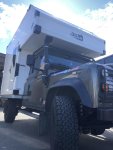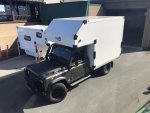You are using an out of date browser. It may not display this or other websites correctly.
You should upgrade or use an alternative browser.
You should upgrade or use an alternative browser.
Total Composites Slide In Camper Kits
- Thread starter Victorian
- Start date
Victorian
Approved Vendor : Total Composites
Nice! What is printed on the warning sticker?
Don't climb in bed area without camper being secured to truck.
Kofi Levermann
New member
I know it adds some "vehicle specific" work, but what are the chances that if someone was ordering a slide-in kit that they could have the design altered to bump out the rear corners to full bed-width (aft of the wheel wells). I realize it adds several more panels and joints (inside corners, especially), but on the smaller beds, having at least a small portion of the floor-pack that's full-width can make a big difference in fitting everything into a layout. (Good spot for storing a porta-potti out of the aisle, for example.)
Obviously this should include an upcharge due to the extra complexity, but if I were ordering a camper, it's one I'd willingly pay.
View attachment 645962
The fact that bed space is wasted as Herbie said, is the reason why am not considering TotalComposites. I mean I could really use that space... at least a bit of it. You could also make it a storrage box with extra lil door, to access from outside, for those that wanna store firewood.
The gab kinda destroys the look, it should be filled. I like everything else though
Alloy
Well-known member
While I’m not aware of any specific failures, I as a builder definitely don’t want one of these types of failures to happen with one of our campers, therefore I’ll take these precautions into consideration based on the client’s needs. a live testing and not just computer simulations to find the failure point would be costly. The difference between these composite shells and typical conventionally build shells is that these aren’t reliant upon internal framework for structure and instead relies upon the shell and extrusions for structure. What is achieved by this is a light weight shell without thermal transfer through the walls/corner joints. This does have a slight compromise in the distance we are comfortable (for now) offering full N/S cabover sleeping areas.
Not a hard issue to overcome by adding CF inside the panel or bonding alum. to (inside the box) the panel.
.
rruff
Explorer
Not a hard issue to overcome by adding CF inside the panel or bonding alum. to (inside the box) the panel.
Since CF and aluminum both have a much higher elastic modulus vs FG, they'd be a poor choice for reinforcement. FG would be good but I doubt TC would approve of that.
Alloy
Well-known member
Since CF and aluminum both have a much higher elastic modulus vs FG, they'd be a poor choice for reinforcement. FG would be good but I doubt TC would approve of that.
Reinforcing fiberglass boats with aluminum is done allot.
Alloy
Well-known member
If you look close. There is not much room for widening the rear. You also need access to reach the tie downs.
Blocking the taillights is a no go for us…. That means installing replacements in the camper with added costs.
Might be a good time to bring up CHMSL (center high-mounted stop lamp).
Victorian
Approved Vendor : Total Composites
It's an option for our US customers. This one stays in Canada where marker lights and other additional lights are not required.Might be a good time to bring up CHMSL (center high-mounted stop lamp).
rruff
Explorer
Depends on the application and how you do it. If the bond is good and the aluminum is strong enough to carry the whole load on its own, then you should be fine.Reinforcing fiberglass boats with aluminum is done allot.
Adding CF to the panel is the same deal... the CF needs to be strong enough on its own. This is because it is ~3x the stiffness of FG (maybe 5x+ the stiffness of FRP skins). CF will fail long before the FRP skin. For instance a good way to ruin a structural FG laminate is to put a thin layer of CF on top for cosmetics and to add a little stiffness. The CF will fail long before the FG, and the integrity is gone. Best to just use FG.
Alloy
Well-known member
It's an option for our US customers. This one stays in Canada where marker lights and other additional lights are not required.
Hope you let customers know. I got stopped crossing the border for not having one.
Alloy
Well-known member
Depends on the application and how you do it. If the bond is good and the aluminum is strong enough to carry the whole load on its own, then you should be fine.
Adding CF to the panel is the same deal... the CF needs to be strong enough on its own. This is because it is ~3x the stiffness of FG (maybe 5x+ the stiffness of FRP skins). CF will fail long before the FRP skin. For instance a good way to ruin a structural FG laminate is to put a thin layer of CF on top for cosmetics and to add a little stiffness. The CF will fail long before the FG, and the integrity is gone. Best to just use FG.
Use enough CF to support 105% of the load so neither the CF or FRP fails. The added material will be in tension at the top and compreesson at the bottom. Both alum and CF are (as you said 3-5X better) for compression.
rruff
Explorer
Use enough CF to support 105% of the load so neither the CF or FRP fails. The added material will be in tension at the top and compreesson at the bottom. Both alum and CF are (as you said 3-5X better) for compression.
3-5x higher stiffness... not strength. FG is much closer in stiffness to the existing structure, so it's better to use that if you want to reinforce it (ie improve the strength) in a specific area.
Hope you let customers know. I got stopped crossing the border for not having one.
Damn... so I need to mount a center brake light on my camper?
Similar threads
- Replies
- 23
- Views
- 3K
- Replies
- 3
- Views
- 1K
- Replies
- 1
- Views
- 1K
- Replies
- 2
- Views
- 838



